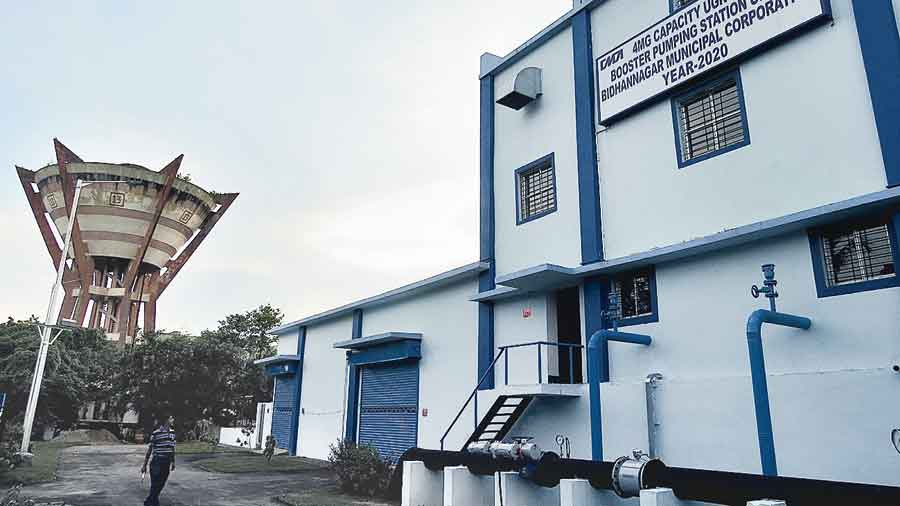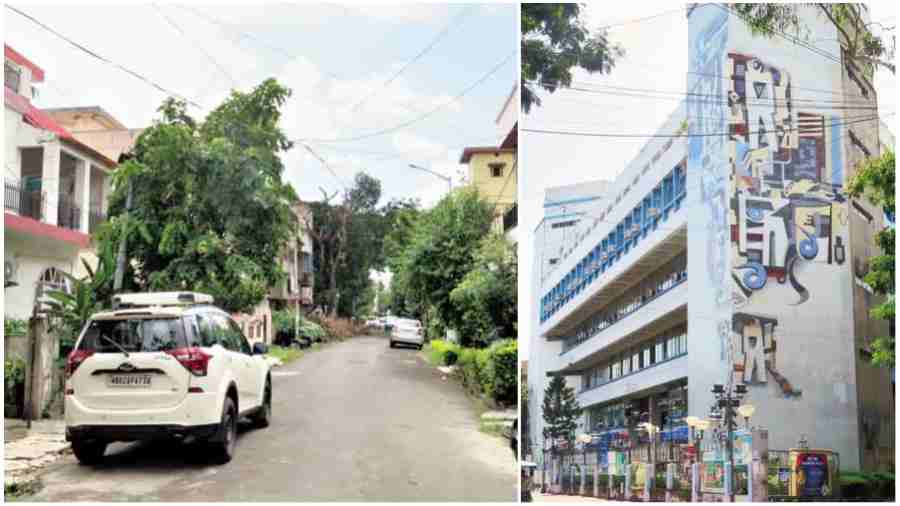The Bidhannagar Municipal Corporation is likely to allow house owners across Salt Lake to build an additional floor, install lifts on two-storey houses and change temporary structures like sheds on rooftops into permanent ones.
The proposal was mooted at a mayoral council meeting a few weeks ago and will need to be cleared before a board of councillors meeting before it gets sanction from the civic body. But sources feel it will readily get passed, given that it can be a source of revenue for the miserably cash-strapped Corporation.
“The plan to allow an extra floor on buildings irrespective of plot sizes has been prepared as it is a long-standing demand from the residents,” said Krishna Chakraborty, mayor of the Bidhannagar Municipal Corporation. “There are many buildings in Salt Lake where owners have created multiple rooms with asbestos or tin roofs. Senior citizens form a sizeable percentage of the township's population and they demand that we allow the construction of lifts for two-storey buildings.”
The construction of lifts have been allowed for a few years now but not for two-storey houses. The new plan would allow that. As for additional floors, only one extra floor would be allowed and that too in individual houses. Housing complexes would not get to build more floors. “Once the plans get passed, we will send the proposal to the urban development department for clearance,” she said.
Most plots in Salt Lake are owned by the urban development department and residents own the buildings while the land is leased out to them, a senior official of the corporation said. Any large-scale change in building plans here will need a clearance from the urban development department.
Money-spinner
A section of civic officials, however, said the move is really an attempt to earn revenue in terms of fees and property taxes.
Although deemed a municipal corporation, the civic body is still dependent on grants from the state government, central government schemes and other external agencies like the Asian Development Bank to carry out both day-to-day activities and to build new infrastructure.
“Allowing an extra floor on a building will augment the civic body’s earnings in the form of fees like building plan approval and since the floor area will increase, it will also hike the annual property tax payable by owners,” said the official.
Property tax forms an important source of revenue for any urban local body, besides parking fee collection, advertisement and hoarding taxes and renting out utilities like ceremonial houses and community halls run by the civic body. But property tax collection is abysmal in Salt Lake.
Owing to an ongoing legal battle on the valuation of property here, many residents have not paid taxes in years. This year, the civic body introduced a higher tax structure without tampering with the area value but still not everyone has paid up.
Without adequate revenue, the services provided by the corporation are suffering.

Points of concern: Cars parked on both sides of a street. Door-to-door garbage pick-up.
Debasmita BhattacharjeeRoads dark & damaged
Such is the cash crunch that a civic official said that even emergency work on repairs of roads, sewerage, drainage and streetlights had been put on hold, barring a few cases.
Anyone travelling across the township would have faced the potholes that have emerged all over. The Telegraph Salt Lake spoke to several contractors involved in building and repairing the road network here and nearly everyone said their bills had not been cleared in the past couple of years or more.
“We had been awarded a tender to repair a stretch of road in AD Block. We finished the work in 2019. Every other day, I turn up at the Corporation headquarters hoping to hear some news about my payment,” said a contractor who did not wish to be named.
While awarding tenders, the civic body makes it mandatory for the contractor or agency, that has relaid the road, to maintain it for five years but several contractors said that since their bills have not been fully cleared in the first place, they don’t have the funds to carry out repairs.
Mayor Chakraborty has on multiple occasions blamed agencies that are not carrying out repairs based on the annual maintenance scheme but the contractors say their hands are tied as they themselves are struggling to make ends meet without receiving payments.
The situation is no different with regards to streetlights that have gone dark in several main roads and lanes. An agency that installed lights and was tasked with their maintenance confessed they were changing lights in “important places only”.
“We have no choice and are having to pay from our own pocket to change the lights. The bills are getting cleared extremely late,” said the contractor, requesting not to be named.
A senior civic official went so far as to say that a section of officials and engineers were worried when their salaries would stop getting paid on time. “This seems to be the predominant topic of discussion during our breaks these days,” he said.
Old attempt
The proposal for extra floors is not a new one. In 2005, the then Left Front municipal board led by chairman Dilip Gupta had sought clearance from the state government to allow Salt Lake houses to have one room on the rooftop for domestic helps.
This was, however, shot down by the then chief minister Buddhadeb Bhattacharjee citing reservations about civic infrastructure falling short.
But in 2010 the Left front government approved a proposal to allow vertical growth of the township. Before that, only single-storeyed structures were allowed on two-cottah and three-cottah plots and G+4 buildings could only be built on plots measuring more than two or three cottahs.
But after 2010, the rules allowed the construction of G+2 buildings on two-cottah plots and G+3 structures on three or four cottah plots. G+5 buildings were cleared on plots of eight or nine cottahs while G+8 buildings were cleared for plots measuring 10 cottahs.
While details of the 2022 proposal are yet to be approved, a section of councillors is already upbeat. “Salt Lake needs to grow. Since most plots here are already leased out, we have no option but to grow vertically. It is a long-standing demand of the residents,” said Tulsi Sinha Roy, councillor of Ward 40.
The downside of more floors — and the resultant growth in population — however could be the pressure on infrastructure.
Load on buildings
Architect Abin Chaudhuri said that in terms of adding lifts, people have a range of options that don't need much alteration to the building and that some can even be completely independent resources.
“However most buildings in Salt Lake are more than 30 years old and one must ideally get a structural engineer or architect to check the existing building plan before adding a floor,” he said. “As a thumb rule, both structural and civil engineers design the foundation of a house with provision to add extra floors at some point of time. So in most cases they make the foundations such. However it is always recommended to get the plan checked before an addition is undertaken,” he said.
In case a resident has lost the building plan, Chaudhuri said there are agencies to conduct “health check-ups on the house”. “Nowadays we have a variety of sensor-based tests to reveal how strong the structure of the house and foundation is. In case someone doesn’t have the old building plan, these tests can be conducted to figure out if the structure is strong enough to bear the extra load,” he said.

Supply source: The pumping station above the reservoir of 3MG capacity next to Tank 5 in AF Block.
Sudeshna BanerjeeWater
Several councillors said they were sure that the additional water being supplied from the New Town treatment plant would meet the requirement if extra floors were added.
“We are getting adequate water and our drainage network is being regularly cleaned and checked. I don't think there will be issues if owners decide to add extra floors,” said Anita Mondal, councillor of Ward 30.
Salt Lake is getting around 10 million gallons per day (MGD) of water from the New Town water treatment plant at present.
Drainage
This may be a challenge since the township's drainage lines are old and have never been completely revamped, an official of the civic body’s sewerage and drainage department said.
Waste disposal
The same official, who also looks after the solid waste department, said that if the proposal goes through they would have to double the number of garbage collection trucks as well as recruit more manpower.
“We have an existing fleet of around 25 trucks that collect waste. Out of this, we are able to use only 20-22 on any given day due to breakdown and maintenance schedules of the trucks. In case this proposal comes through, we will need more manpower and trucks to provide seamless services. Of course, that would cost a lot of money,” he official.
Parking
Secretary of the Bidhannagar (Salt Lake) Residents' Welfare Association, Sarat Mullick, was worried about parking even more cars on already limited road space. “If the civic body is able to handle the extra pressure, many residents will build an extra floor. But the corporation must keep in mind that people already park their cars on roads in front of their houses, creating enough trouble for others. Extra floors would add more cars to the fray,” he said.






